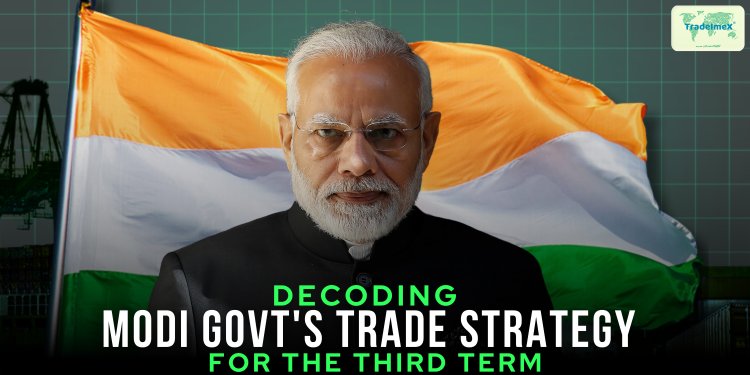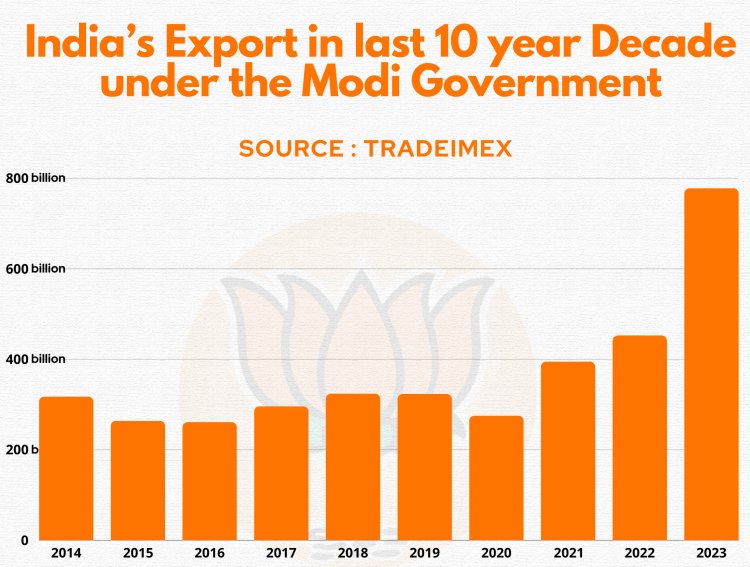Decoding Modi Govt's Trade Strategy for the Third Term: A New Era of trade opportunities in India
Discover how Modi's third-term trade strategy is set to revolutionize India's economic diplomacy in term of trade import export. Unveil a new era of trade opportunities and growth.

Decoding Modi Govt's Trade Strategy for the Third Term: A New Era of Economic Diplomacy in India
As to the June 4 announcement of the results of the Indian general elections, Prime Minister Narendra Modi has been re-elected to a third term in office. Prime Minister Narendra Modi aims to implement a slew of business-friendly policies, including legislation that makes it easier to hire and fire employees, claims two government officials who know the situation. Mr. Modi desires to provide subsidies for local manufacturing displayed after the most recent goods for semiconductor companies and electric vehicle producers, according to officials who spoke on the condition of privacy considering they weren't allowed to talk to the media. He also intends to lower import duties on crucial inputs for domestically produced items, which have raised India's manufacturing costs, according to authorities.
Trade Aspirations for Modi 3.0
Making India the third-largest economy by 2027 along with solidifying its position as a global leader is one of the Modi Government's major ambitions. It might not be too hard for India to move up to the third position among the world's economic powers, given its current GDP growth rate of 8.5 percent, which makes it the largest economy growing at the quickest rate in the world. When Modi took office in 2014, India was ranked 10th; since then, it has risen to the fifth rank. India is on track to grow to be the 1/3-largest economy in the world by way of 2027, in line with both local and worldwide indices. To align with the ambitions of creating a Developed India by using 2047, comprehensive reforms will be applied at some stage in Modi's 0.33 time period. The timetable will encompass market reforms, the merchandising of unfastened alternate agreements, a focus on digital infrastructure and the strength transition, and bolstering the kingdom's monetary resilience to resist shocks to the arena economy.
Increasing India's share in manufacturing globally
India is the major economy that is growing the fastest, but it is divided between a thriving technology industry and a faltering older economy that does not generate enough jobs for everyone else, according to Josh Felman, the former chief of the International Monetary Fund's India office. India has successfully attracted suppliers for large US firms such as Apple Inc and Alphabet Inc's Google. However, the country accounts for less than 3% of global manufacturing, compared to China's 24%, according to World Bank figures. According to an internal document obtained by Reuters, the government intends to expand India's global manufacturing contribution to 5% by 2030 and 10% by 2047. It did not disclose specifics.
Ambitious Goals: Doubling India's GDP by 2030 under Modi's Leadership
In an attempt to make India's economy the third biggest globally, he's re-elected for a 3rd time, Indian Prime Minister Narendra Modi has mounted an ambitious intention of doubling the nation's GDP and exports this decade. He has requested that plans be finalized to grow the nominal length of the financial system from about $3.51 trillion to $6.69 trillion by 2030. According to research, it would be a "very tough feat" to double the economic system by the quilt of the last decade and could require a boom of between 6% and 6.5%. According to the document, Modi wants to increase per capita income to $4,418 from about $2,500 over the next six years, but it doesn't mention what kind of reforms or expenditures will be required to get there. As per the document, Modi's administration hopes to increase goods and services exports from approximately $700 billion to $1.58 trillion by 2030. This might increase India's export proportion to more than 4% of world commerce.
Labor reforms
Employers employing more than 100 workers must obtain state government authorization before they may hire or fire someone in much of India. As a result, businesses are unable to modify their operations to satisfy demand, according to Atul Gupta, a partner at the Bengaluru law firm Tri Legal. Legislation that would raise the bar for official approval to 300 has been enacted by parliament, but the process has been slowed down by State authorities who must approve the adjustments. Prime Minister Modi anticipates that a resounding victory on June 4th will provide him with the political capital and impetus to overcome their opposition.
Increased tariffs
Tariffs on imports, which include parts for luxury manufacture, drive up production expenses in India as well. india reduced import taxes on components to 10% to boost smartphone manufacturing. However, the India Cellular and Electronics Association claims that rival Vietnam already charges rates ranging from 0% to 5% on comparable inputs. According to World Trade Organization (WTO) data for 2022, the most recent year for which information is available, India's average import tariff on WTO members was 18.1%, whereas China's was 7.5%. According to Mr. Gao, customs procedures are also substantially easier and faster in China. According to an SMU professor, imports may cross customs in China in roughly 20 hours. In India, it takes 44 to 85 hours, as per a government study in 2023.
India’s Export Trends in the Last Decade under the Modi Government

|
Year of Trade |
Total Value of Exports |
|
2014 |
$317.54 billion |
|
2015 |
$263.88 billion |
|
2016 |
$260.96 billion |
|
2017 |
$295.86 billion |
|
2018 |
$323.99 billion |
|
2019 |
$323.25 billion |
|
2020 |
$275.48 billion |
|
2021 |
$394.81 billion |
|
2022 |
$452.68 billion |
|
2023 |
$778.20 billion |
India’s Interim Budget macroeconomics for the fiscal year 2024-25
The trade strategies for India’s economic growth look secure and stable as far as its budget is concerned. India’s Budget for its trade opportunities and economic growth in the fiscal year 2024-25 holds a strong vision under the Modi government for its third-term reign. Some of the major trade insights and budget macroeconomics for India’s budget in the fiscal year 2024-25 include:
- 5.1% of GDP is the target fiscal deficit for FY25.
- The budget deficit for FY24 is 8% of GDP.
- By FY26, the government hopes to reduce the deficit to less than 4.5%.
- Capital spending in FY25 at 3.4% of GDP.
- An estimated ₹11.75 lakh crore will be borrowed from the net market in FY25.
- In FY24, gross market borrowing totaled ₹14.1 lakh crore.
- FY24 Updated Budget Estimates of ₹44.90 lakh crore
- ₹50,000 crore is the goal amount for FY25 divestment.
- The ₹30,000 crore divestment goal for FY24 was dropped.
What effects might a third term of Modi have on the Indian economy?
The expected win of Prime Minister Narendra Modi in the country's general elections has spurred much conjecture about the consequences for the trade landscape and growth trajectory of India, as the country is ready to start another phase in its political and economic trajectory. Industry executives and economists are keeping a close eye on the impending third term to identify the strategic priorities and important policy directives that could influence India's economic future. These include:
- Industrial Modernization and Manufacturing Should Be Prioritized.
- Reducing Labor Reforms and Regulatory Burdens.
- Specific Sector-Level Incentives.
- Accelerating the Transition to Renewable Energy.
- Making the Most of Renewable Energy.
- Finding a Balance Between Sustainability and Growth.
- Taking Advantage of Digital Transformation's Power.
- Developing the Public Digital Infrastructure.
- Promotion of Entrepreneurial Environments.
- Dealing with Ongoing Issues.
- Overcoming the Rural-Urban Gap.
- Handling Geopolitical Tensions.
Conclusion
To conclude, Modi's trade strategy for the third term heralds a new technology of financial diplomacy in India, with a focal point on selling monetary boom, fostering innovation, and strengthening diplomatic ties. By embracing loose trade agreements, strengthening regional partnerships, and addressing key challenges, India can chart a direction in the direction of monetary prosperity and international competitiveness under Modi's management.
Read more :-
India’s Ambitious Interim Union Budget 2024-25
India’s Tour Of France: How It Will Affect The Bilateral Trade Between India and France?
Russia Turns to India for Banana Amidst Ecuador Conflict
What's Your Reaction?














